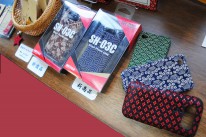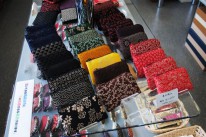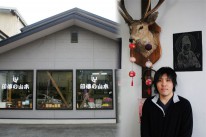inden-yamamoto
Coporate Profille
Before the World War II, Yusuke Yamamoto’s grandfather Kinnosuke worked at an old Inden store. Inden, a form of leather craft, is proud to own a long history of 400 years. After the war Kinnosuke’s superior technique gave him confidence to establish the Yamamoto Shoten, which deals with original leather products including children’s satchels. Moreover, influenced by culture trends from United States, Kinnosuke created products that blended the novelty concepts into the traditional Inden.
Makoto, the successor of Inden-making from Kinnosuke, is the only craftsman in Japan who has been certified by the Ministry of Trade, Industry and Economy as the traditional “Koshu Inden Craftsman”. Currently, Yusuke Yamamoto has succeeded Makoto’s position in the company.
Story
Inden is a form of craftsmanship, which involves dyeing deerskin with dye and smoke, before lacquering and processing them. The original leather craftsmanship is originated from China since year 500 A.D. The name of this technique Inden, is said to have come from Indian Sarasa craftsmanship, which incorporate geometric designs. During the war period, its lightness and durability were highly regarded and therefore used as materials for armour. Shingen Takeda used this material for his armour, enhancing his superiority. He is also the person who laid the founding stone of its technique and established the production grounds in Yamanashi prefecture. In the Edo era, major leather products are wallets and other daily necessities.
Interview
I felt the need to preserve and promote the tradition and situation of Inden as a highly regarded traditional craftwork. However we are challenged to modify and diversify the functions and uses of Inden without altering its exterior appearance. Traditional craftwork is usually not too popular among young customers, but by introducing contemporary fashion elements and style into our products, we hope that young people would patronize our goods as well. This is an approach to carry Inden culture into the future generations. Though deer leather is the most commonly used leather material in Japan, we wish our products could break through geographical, cultural boundaries and produce products loved by many people, and to let them know about the charms of this material.
Recommendation
Inden used to be a casual belonging by commoners during mid-Edo period (18th century), but has since then diversified into a wide range of goods such as bags and coin purses during Meiji period. The strength of Inden lies in its flexibility to produce goods that match the specific needs of people in a certain era. The design, which forms the basis of the craft, has about 50 different traditional patterns, but has expanded to over 200 patterns in the Heisei era.
Also, it has expanded to undiscovered new paths, with the iconic product as smart phone cases. Smart phone cases are tailor-made and each case takes about 1 month to complete. The price is about 8000 yen. A wide range of 15 colours of leather, 5 colours of lacquer and 250 patterns of design is available. Customers can choose freely from a total of 10,000 combinations. The love for single craft products has not faded since the past.
Creative additions and modifications to conventional products such as collaborations with games are targeted at young customers.
On the other hand, conventional goods such as bags and purses have also been reviewed. New additions such as the increase of number of card pockets for wallets have been implemented to suit the needs of people today. Relatively cheap seal cases around 10,000 yen are also popular formal gifts.




